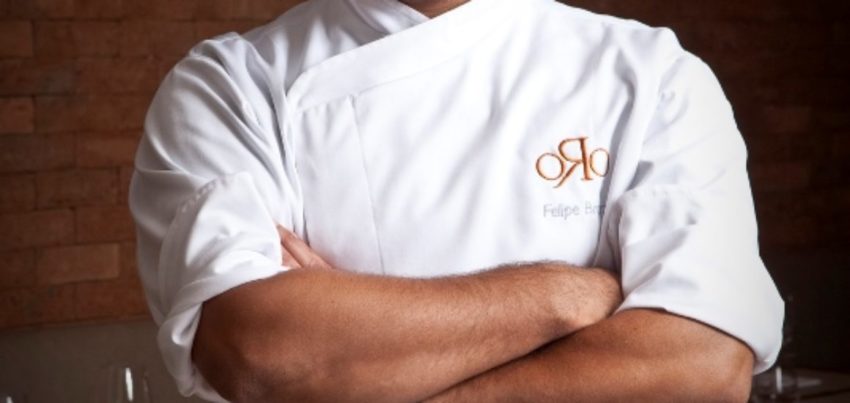
On a recent evening in Rio de Janeiro, I went out for dinner at Rua Dias Ferreira in Leblon. At first glance, the word Pipo would seem no more than a cute word to pronounce in Portuguese. But read through this restaurant’s menu, on which one fanciful tapa dish leads to another, and then another after that, and you realize that its name is actually the nickname of a trendsetter carioca chef, Felipe Bronze.
Having trained at the CIA cooking school in Hyde Park (NY), Felipe Bronze (Pipo for those who know him from childhood), had stunts at many legendary New York kitchens like Nobu and Le Bernardim. When he returned to Rio in 2001, he went to work for Sushi Leblon, one of the most profitable restaurants in Rio, also located at Rua Dias Ferreira. He then continued his career in the kitchens of Zuka, Z Comtemporaneo, and Hoteis Marina.

After a series of kitchen jobs, Felipe partnered with restauranteur Eurico Cunha, and together they opened Oro in October 2010, a restaurant in Jardim Botânico that took Rio by storm. Other chefs in Brazil have embarked on a similar path, but Oro stands out. It reaches a level of art in cooking, an idealization of ingredient interpretation.

For a foodie like me, it’s as if you take the dream of eating at El Bulli (already closed) and place it Rio. Even better actually, because Bronze applies that level cooking to Brazilian cuisine rather than Spanish, and what he does in the process is a hurricane of creativity.

As you sit, even the napkin comes in a thrilling form of candy that opens up to a hot towel. Salad Caprese with Burrata, comes with a tomato dome. Capelini a Carbonara is an indulgent affair, with a creamy sauce, bacon bits and a perfectly cook egg on top.

Feijoada comes deconstructed; to each and every item of the traditional dish, special treatment and attention is given to it. On the plate, you taste Brazil on a luxe scale. Chocolate ice cream with a crunchy Licuri (a fruit from the Amazon) comes with foams and smokes, not to mention table side preparation.

Oro is a lifetime experience. The level of cooking and detail is overwhelming, proving that Bronze’s talent in the kitchen is sometimes breathtaking. But is it worth it? That is the question that cariocas are asking themselves, especially now, ever since the recession seemed to have knocked on Brazil’s door.
Indeed, I had one of the most unforgettable meals of my life, but can I afford to go back? A meal for two at Oro can easily cost $600 Reais (Brazilian currency, around US$250), and that’s just starting point.
Let’s not forget the context in which Oro opened. The year was 2010. While the rest of the world was crumbling into deep recession, Brazil was growing at a rate of 7,5%, the highest in 24 years. Oh, glory days!
Oro reflects that moment of Brazil, a restaurant that speaks to a time of splendor, and its success was bound to encourage more of it. Which bring us back to Pipo.
This small restaurant, with its tables open to the street was the last place I’d expect to feel like a “carioca da gema” (that’s an expression for hard core cariocas) after dinning at Oro. But Felipe Bronze managed to deliver an experience that is once transcendent and deeply rooted in Brazilian street foods, to the wallet of cariocas.
Pipo opened doors in July of 2013, bringing him back to Rua Dias Ferreira, and offering culinary delights in a looser way, more in sync with the culture and current economy of Rio de Janeiro.
The heavenly Bolinho de Pirarucu (Pirarucu Fritters) came from the deep rivers of the Amazon, a riff on Bolinho de Bacalhau (Cod Fritters), though this fish is quite a contender for the cod salting process, and in the north of the country, you may find similar versions.

Pastel de Queijo (Fried Cheese Empanadas) has an onion twist, fried and crunchy, simple, and perfectly executed.

Caldinho de Feijão (Black Bean Broth) with a collard green foam is delightful.

Crème de Abacate ( Avocado Cream) comes with a crunch of macademia, brittly and delicious.

Aipirm Frito (Yucca Fries) comes with a foam of Coalho cheese, rich and creamy.
All these flavors, all this food for thought are the first few bites of an array of petiscos. Pipo leaves us with an appreciation for excellent cheap eats. The flavors are so robust and the enviroment as carioca as any botequim. I am not sure if I can afford another meal at Oro. But at Pipo, I can—and I get the same fandango! Can’t wait to go back!
Pipo
Rua Dias Ferreira, 64 Lojas B e C
Leblon, Rio de Janeiro
Tel (55 21) 2239-9322
Oro
Rua Frei Leandro, 20
Jardim Botanico, Rio de Janeiro
Tel: (55 21) 7864-9622

